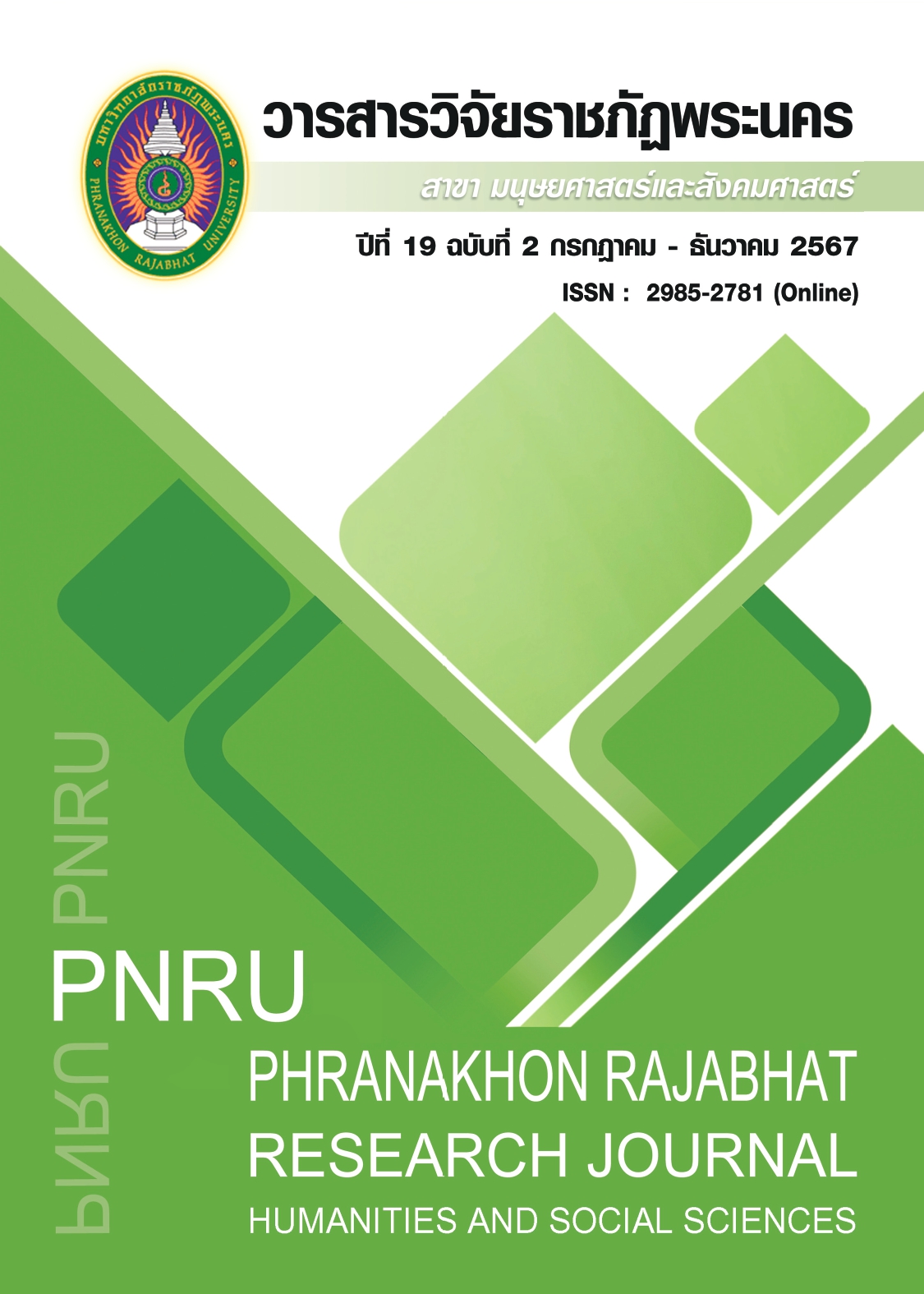นโยบายการบริหารทรัพยากรมนุษย์เชิงยุทธศาสตร์ของกรมส่งเสริมการเรียนรู้ กระทรวงศึกษาธิการ
Main Article Content
บทคัดย่อ
การวิจัยนี้มีวัตถุประสงค์เพื่อ 1) ศึกษาสภาพการณ์ของนโยบายการบริหารทรัพยากรมนุษย์
เชิงยุทธศาสตร์ของกรมส่งเสริมการเรียนรู้ กระทรวงศึกษาธิการ 2) ศึกษาความสัมพันธ์ระหว่างการบริหารทรัพยากรมนุษย์เชิงยุทธศาสตร์กับความสำเร็จของนโยบายการบริหารทรัพยากรมนุษย์เชิงยุทธศาสตร์ของกรมส่งเสริมการเรียนรู้ กระทรวงศึกษาธิการ 3) เสนอแนวทางในการพัฒนานโยบายการบริหารทรัพยากรมนุษย์เชิงยุทธศาสตร์ของกรมส่งเสริมการเรียนรู้ กระทรวงศึกษาธิการ การวิจัยนี้เป็นการวิจัยแบบผสมวิธี การวิจัยเชิงปริมาณ ประชากร คือ ข้าราชการ พนักงานราชการ และลูกจ้างของกรมส่งเสริมการเรียนรู้ในส่วนกลาง จำนวน 432 คน โดยสำรวจจากกลุ่มตัวอย่าง จำนวน 208 คน เครื่องมือที่ใช้ศึกษา คือ แบบสอบถาม สถิติที่ใช้ในการวิเคราะห์ข้อมูล ได้แก่ ความถี่ ร้อยละ ค่าเฉลี่ย ค่าส่วนเบี่ยงเบนมาตรฐาน และการวิเคราะห์โดยวิธีการสัมประสิทธิ์สหสัมพันธ์เพียร์สัน การวิจัยเชิงคุณภาพ ประชากร คือ ผู้บริหารหน่วยงานที่กำกับดูแล จำนวน
12 คน โดยเลือกกลุ่มตัวอย่างแบบเจาะจงผู้บริหารของหน่วยงานระดับผู้อำนวยการกลุ่มในส่วนกลางที่มีความเชี่ยวชาญและมีภารกิจหลักในการกำกับดูแลงานด้านนโยบายการบริหารทรัพยากรมนุษย์เชิงยุทธศาสตร์
ของกรมส่งเสริมการเรียนรู้ จำนวน 3 คน เครื่องมือที่ใช้ศึกษา คือ แบบสัมภาษณ์
ผลการวิจัยพบว่า 1) สภาพการณ์ของนโยบายการบริหารทรัพยากรมนุษย์เชิงยุทธศาสตร์
ของกรมส่งเสริมการเรียนรู้ กระทรวงศึกษาธิการ พบว่า ปัจจัยการบริหารทรัพยากรมนุษย์เชิงยุทธศาสตร์
ในภาพรวมทั้ง 4 ด้าน อยู่ในระดับมาก โดยการดำเนินงานตามนโยบายการบริหารทรัพยากรมนุษย์เชิงยุทธศาสตร์ของกรมส่งเสริมการเรียนรู้ กระทรวงศึกษาธิการ ไปปฏิบัติยังมีข้อจำกัดบางประการ ได้แก่
การวิเคราะห์งานและวางแผนกรอบอัตรากำลังไม่สอดรับกับภารกิจงานในปัจจุบันของกรมส่งเสริมการเรียนรู้ แผนการพัฒนาและฝึกอบรมยังไม่มีความหลากหลาย และทันสมัย และยังขาดการส่งเสริมนโยบายในการเสริมสร้างแรงจูงใจให้กับบุคลากรที่มีความสามารถให้มีความก้าวหน้าในสายงานอาชีพ 2) ปัจจัยการบริหารทรัพยากรมนุษย์เชิงยุทธศาสตร์มีความสัมพันธ์เชิงบวกกับความสำเร็จของนโยบายการบริหารทรัพยากรมนุษย์เชิงยุทธศาสตร์ของกรมส่งเสริมการเรียนรู้ กระทรวงศึกษาธิการ อย่างมีนัยสำคัญทางสถิติ
ที่ระดับ 0.01 3) แนวทางการพัฒนา พบว่า ด้านการสรรหาและคัดเลือกทรัพยากรมนุษย์มีความสัมพันธ์กับความสำเร็จของนโยบายการบริหารทรัพยากรมนุษย์เชิงยุทธศาสตร์น้อยที่สุด จึงควรจัดสรรทรัพยากรในด้านบุคลากรให้เพียงพอ เหมาะสม และสอดคล้องกับภารกิจ ควรสนับสนุนให้บุคลากรได้อบรมตามสายงานอย่างสม่ำเสมอ และควรสนับสนุนและส่งเสริมเส้นทางความก้าวหน้าในสายอาชีพของบุคลากรให้มีความชัดเจนและเหมาะสม รวมทั้งส่งเสริมคนดี คนเก่ง และมีศักยภาพสูง เพื่อเสริมสร้างแรงจูงใจและขวัญกำลังใจแก่บุคลากรให้สูงขึ้น
Article Details

อนุญาตภายใต้เงื่อนไข Creative Commons Attribution-NonCommercial-NoDerivatives 4.0 International License.
บทความที่ได้รับการตีพิมพ์เป็นลิขสิทธิ์ของมหาวิทยาลัยราชภัฏพระนคร
ข้อความที่ปรากฏในบทความแต่ละเรื่องในวารสารวิจัยราชภัฏพระนครเล่มนี้เป็นความคิดเห็นส่วนตัวของผู้เขียนแต่ละท่านไม่เกี่ยวข้องกับมหาวิทยาลัยราชภัฏพระนคร และคณาจารย์ท่านอื่นๆในมหาวิทยาลัยฯ แต่อย่างใด ความรับผิดชอบองค์ประกอบทั้งหมดของบทความแต่ละเรื่องเป็นของผู้เขียนแต่ละท่าน หากมีความผิดพลาดใดๆ ผู้เขียนแต่ละท่านจะรับผิดชอบบทความของตนเองแต่ผู้เดียว
เอกสารอ้างอิง
Chantarasook, P., & Sucharitrak, P. (2023). Human resource management and organizational commitment of personnel in vocational college Ratchaburi. Vocational Education Central Region Journal, 6(1), 40-49.
Gitman, J. & McDaniel, C. (2008). The future of business: The essentials. (4th ed.) Ohio: South Western Cengage Learning.
Ivancevich, M. (2006). Human resource management. New York: McGraw-Hill Inc.
Juito, S. (2012). The new dimension of human capital management. Nonthaburi: The Office of the University Press Sukhothai Thammathirat Open University.
Laohanan, S. (2005). Human resource management. (2nd ed.). Bangkok: Thana Printing Limited Partnership.
Learning Encouragement Act, B.E. 2566. (2023, March 19). Government Gazette. No. 140 Section 20 A. page 60–72.
Monkong, K., Sriwongwanna, J., & Tankaeo, A. (2022). How human resources management is related to the satisfaction of the operation staffs in the private companies of Muang District, Ubon Ratchathani Province for preparing themselves for the upcoming AEC (ASEAN Economic Community). The 4th National Conference Faculty of Business Administration and Management (119-131). Ubon Ratchathani : Ubon Ratchathani Rajabhat University.
Office of the Civil Service Commission. (2014). Guidelines for setting human resource management indicators according to the HR Scorecard. Nonthaburi:Uptureyou Createnew Co.,Ltd.
Pongsri, O., & Chamaram., S. (2016). The relationship between human resource management and the efficiency of official performance of District Government Offices in Roi Et Province. NRRU Community Research Journal, 10 (1), 53-63.
Sirichotiratana., N. (2017). The principles of human resource management in The 21st century. (2nd ed.). Bangkok: Chulalongkorn University Press.
Thepwan, P. (2012). Strategic human resource management : Concepts and strategies for competitive advantage. Bangkok: V. Print (1991) Company Limited.
Thosuvonchinda, V. (2014). Human resource management. (5th ed.). Bangkok: Ghaowmai Co.,Ltd.
Udomwisawakul, N. (2017). Public policy agenda setting. Nonthaburi: The Office of the University Press Sukhothai Thammathirat Open University.
Wongsrangsap, V. (2015). Human resource management affecting performance efficiency of Employeesin S.G. Center Co.,Ltd. (Master of Science Program). Sripatum University, Bangkok.
Yamane, T. (1973). Statistics: An introductory analysis. New York: Harper & Row.
Yhamdonprai, T., & Ratchapattayakom, C. (2018). Factors relating to core competency of general administrative officers in operating level of Naresuan University. Journal of Faculty of Education Pibulsongkram Rajabhat University, 5(1), 97-110.


